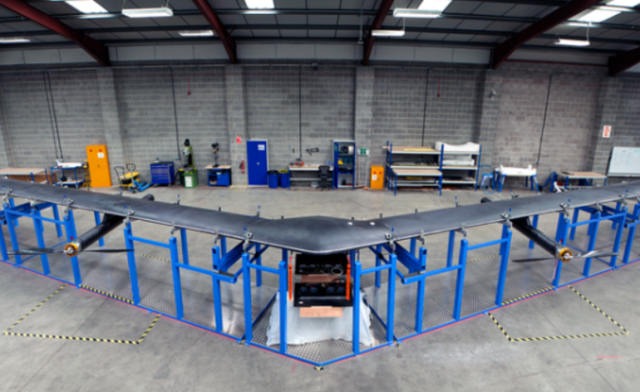 Facebook’s aerospace team in the UK has completed construction of its first full-scale aircraft, called the Aquila, as part of its Internet.org effort. Aquila is a solar-powered unmanned plane designed to beam down Internet connectivity from the sky
Facebook’s aerospace team in the UK has completed construction of its first full-scale aircraft, called the Aquila, as part of its Internet.org effort. Aquila is a solar-powered unmanned plane designed to beam down Internet connectivity from the sky
Facebook CEO Mark Zuckerberg revealed in March that the Aquila has the wingspan of a Boeing 737, but it weighs less than a car and can stay in the air for months at a time. Now, however, Facebook has not only completed construction of Aquila, it also claims a breakthrough in laser communications technology.
“We’ve successfully tested a new laser that can transmit data at 10 gigabits per second. That’s ten times faster than any previous system, and it can accurately connect with a point the size of a dime from more than 10 miles away,” Zuckerberg said in his Facebook post.
It’s all part of Facebook’s Internet.org initiative to connect the unconnected. Since the initiative was launched, its mission has been to find ways to provide Internet connectivity to the more than 4 billion people who are not yet online. Many of them live within range of a 3G signal and working with mobile operators over the past year has provided more than a billion people with access to basic Internet services, said Jay Parikh, VP of Global Engineering and Infrastructure at Facebook, in a post. However, that doesn’t reach everybody.
“With Aquila, we’ve designed a new aircraft architecture, one that can support staying in the air for months at a time,” explained Yael Maguire, head of Facebook’s Connectivity Lab, in a blog post. “Aquila is solar powered, and when launched, it will create a 50-km communications radius for up to 90 days, beaming a signal down to the people in that area. This signal will be received by small towers and dishes that will then convert it into a Wi-Fi or LTE network that people can connect to with their cellphones and smartphones.”
Facebook can rotate its drones every three months with a near-instantaneous handoff, Maguire told The Wall Street Journal. He also told the WSJ that he wants to take advantage of highly efficient semiconductors used in the cellular industry, but the battery technology required does not yet exist. In addition, regulatory issues are more likely to slow the program down than technology, as it still needs to sort out radio frequency spectrum issues and get approval for flying over countries’ airspace.
“Using aircraft to connect communities using lasers might seem like science fiction,” Zuckerberg wrote. “But science fiction is often just science before its time. Over the coming months, we will test these systems in the real world and continue refining them so we can turn their promise into reality.”
Facebook says it is exploring a number of different approaches to the challenge of connecting people in remote areas, including aircraft, satellites and terrestrial solutions. “Our intention is not to build networks and then operate them ourselves, but rather to quickly advance the state of these technologies to the point that they become viable solutions for operators and other partners to deploy,” Parikh stated.
Facebook’s go-to strategy doesn’t sound that far off from what Google (NASDAQ: GOOG) is doing in terms of showing what can be done. Interestingly, Google’s Head of Moonshots, Astro Teller, said during the I/O conference that the company tries to fail fast at its ideas in order to discover what doesn’t work so that it can move on to other concepts.
The goal of Project Loon is to beam Internet service from balloons floating in the stratosphere down to the 4 billion people who don’t currently have a good connection. That project calls for “flying cell towers” that talk to each other in the stratosphere and ultimately provide uninterrupted Internet service. The company has deals with Vodafone, Telefonica and Telstra and is talking to others.
Source: Fierce Wireless
